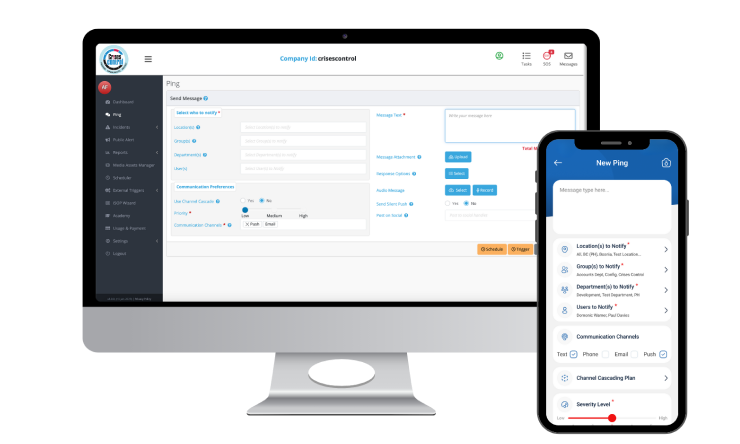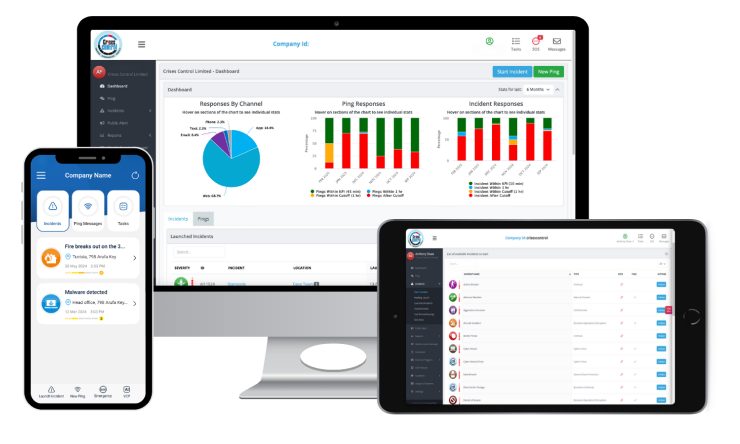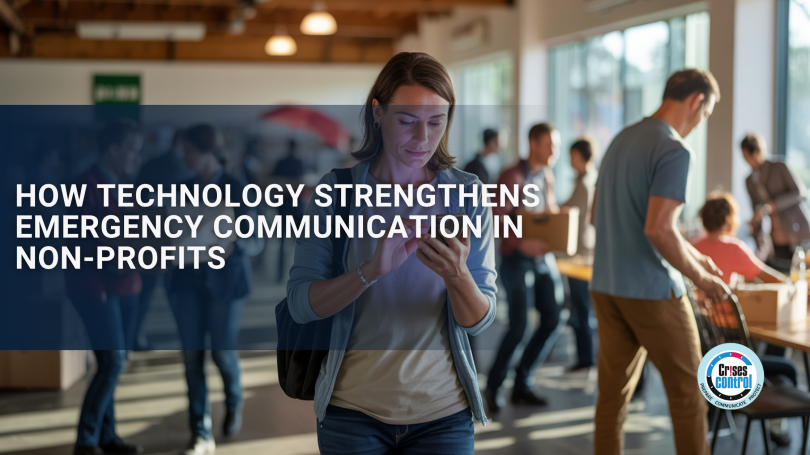Written by Anneri Fourie | Crises Control Executive
Imagine a small community centre on a busy afternoon. Volunteers are helping families, answering phones, and sorting donations when suddenly, a fire alarm sounds. People look around, unsure of what to do next. A few check their phones, but there are no instructions. In moments like this, clear communication can mean the difference between confusion and calm.
For many non-profit organisations, emergencies like this are part of the reality of serving communities. From extreme weather to cyber incidents or safeguarding concerns, risks can appear without warning. The challenge isn’t just responding quickly, but ensuring everyone knows what to do.
That is where technology transforms emergency response. With modern Emergency Communication tools such as Mass Notification Software, non-profits can reach every member of staff or volunteer instantly, no matter where they are. Real-time alerts, two-way messaging, and automatic reporting help organisations stay connected, coordinated, and accountable.
This blog explores how technology strengthens emergency communication in non-profits, supports safety and compliance, and highlights how Crises Control’s Ping Mass Notification module helps build safer, more resilient operations.
The Role of Emergency Communication in Non-Profits
Non-profit organisations often operate in unpredictable environments. They may run shelters, community programmes, or international relief efforts; all with limited staff, diverse teams, and growing responsibilities. When emergencies strike, keeping everyone informed can be difficult.
Traditional communication methods such as phone trees, group texts, or email lists often fail when pressure is high. They are slow to update, hard to monitor, and leave gaps that can delay response times. Effective Emergency Communication for non-profits requires a system that can deliver accurate information instantly, confirm who has received it, and allow leaders to see what actions are being taken.
Mass Notification Software provides that structure. It brings together alerts, acknowledgements, and reporting into one reliable platform. This helps organisations move from reactive responses to proactive control. Instead of trying to manage multiple communication channels, leaders can focus on managing the situation itself.
How Technology Improves Safety and Speed
Digital technology has changed the way organisations prepare for and handle crises. Non-profits now have access to the same advanced tools that large enterprises use to protect people and maintain operations.
Modern crisis management technology uses automation, real-time data, and cloud-based systems to make emergency communication faster and clearer. These tools simplify coordination and give managers a complete view of what’s happening, helping them make decisions quickly and with confidence.
Technology offers several advantages that directly improve safety and efficiency:
- Centralised information: Store contact lists, communication plans, and message templates in one secure location.
- Real-time updates: Notify staff and volunteers across SMS, voice calls, email, and mobile app notifications instantly.
- Automatic accountability: Track responses and actions to confirm that everyone is safe and informed.
- System integration: Connect communication tools with incident reporting and risk management systems.
When information flows smoothly, non-profits can focus on what matters most, supporting their communities, while knowing their people are protected.
Real-Time Alerts and Faster Decision-Making
During an emergency, delays in communication can make the situation worse. Real-time alerts ensure that everyone receives timely information, whether it’s a fire drill, a data breach, or a safety concern.
For non-profits with dispersed teams or multiple branches, these alerts are essential. They can be used to:
- Notify teams of immediate risks, such as severe weather or building hazards.
- Provide clear evacuation or lockdown instructions.
- Share safe meeting points or temporary closures with volunteers.
- Request assistance or updates through two-way communication.
Crises Control’s Ping Mass Notification module enables this kind of fast, verified communication. Messages are sent through multiple channels at once, ensuring no one is missed. Each alert is tracked, so managers can confirm who has received it and who has responded. This clarity reduces uncertainty and builds confidence in every stage of response.
From Manual Processes to Smart Systems
Many non-profits still rely on manual communication methods because they seem simple or cost-effective. But during an emergency, those systems can quickly fail. Messages get lost, people are missed, and response times slow down.
By adopting digital communication tools for charities, organisations can move from manual, reactive systems to smarter, proactive communication. Automated tools remove guesswork, reduce the risk of error, and ensure every person receives the right information when it matters most.
Crises Control takes this further with automation and customisation. Alerts can be pre-configured for different types of incidents, such as IT outages, health emergencies, or security issues, so they can be triggered instantly. This saves time during high-pressure moments and keeps teams focused on action rather than coordination.
Incident Reporting and Accountability
Once the immediate situation is under control, organisations must understand what happened and how they responded. Accurate reporting is essential for compliance, transparency, and future improvement.
Technology makes this process simple. Automated systems can record:
- Who received each alert and when.
- What responses were given.
- The timeline of communication and resolution.
These records provide a clear audit trail that supports safety obligations and legal compliance. They also help identify what worked well and what can be improved.
Crises Control’s incident reporting feature integrates seamlessly with our Mass Notification System, meaning every action and communication is logged. This makes post-incident reviews faster and more accurate, ensuring lessons learned turn into stronger future responses.
Interested in our Ping Mass Notification Software?
Efficiently alert everyone in seconds at scale with our Mass Notification Software.

Building Trust Through Communication
Strong communication isn’t just about speed; it’s about trust. When information is clear, people feel safer, more informed, and more connected to their organisation. For non-profits that rely on the dedication of staff, volunteers, and donors, that trust is invaluable.
When communication breaks down, people can feel isolated or unsure of what to do. Technology restores confidence by ensuring that messages reach everyone, that information is consistent, and that support is visible.
With systems like Crises Control, leaders can demonstrate their commitment to safety and accountability, strengthening trust not only within the team but also among donors and community partners.
Measuring Efficiency and Return on Investment
For many non-profits, adopting new technology can feel like a luxury. But investing in Emergency Communication systems delivers measurable results that go beyond safety.
Automated alerts and reporting save time, reduce administrative effort, and minimise disruption during incidents. This efficiency allows staff to focus on service delivery rather than logistics.
In the long term, these tools help non-profits meet compliance standards, reduce operational costs, and strengthen their reputation for professionalism and preparedness. Donors and partners are more likely to support organisations that can show they have reliable systems in place to protect people and resources.
A well-managed crisis response isn’t just about avoiding harm; it’s about building confidence in how an organisation operates.
How Crises Control Supports Non-Profits
Crises Control is built to make effective communication simple, no matter the size of the organisation. For non-profits, the Ping Mass Notification module provides an easy-to-use system that delivers speed, reliability, and clarity when it matters most.
It offers:
- Instant, multi-channel alerts that reach people wherever they are.
- Two-way communication to collect updates and confirm safety.
- Automated incident reports for audit and compliance.
- Custom templates to save time during emergencies.
- Mobile access so teams can respond from anywhere.
These features work together to create a safer, more connected environment for staff, volunteers, and communities.
Building a Culture of Preparedness
Technology alone cannot replace human decision-making, but it can enhance it. The most successful non-profits combine reliable systems with training and practice.
Regular drills, clear communication plans, and accessible tools help teams respond confidently under pressure. Crises Control supports this approach by providing features for testing, simulation, and continuous improvement. Each drill helps refine procedures and ensures everyone understands their role.
When technology and people work together, communication becomes second nature; calm, organised, and effective.
Take the Next Step Towards Smarter Communication
Emergencies are unpredictable, but communication doesn’t have to be. With the right tools in place, non-profits can protect their teams, maintain operations, and continue serving their communities without interruption.
Crises Control gives organisations the power to communicate quickly, record every action, and ensure accountability across every department.
If your organisation wants to improve emergency communication and be ready for any situation, contact Crises Control today to book a free demo and see how our technology can help your non-profit stay connected, informed, and prepared for whatever comes next.
Request a FREE Demo

